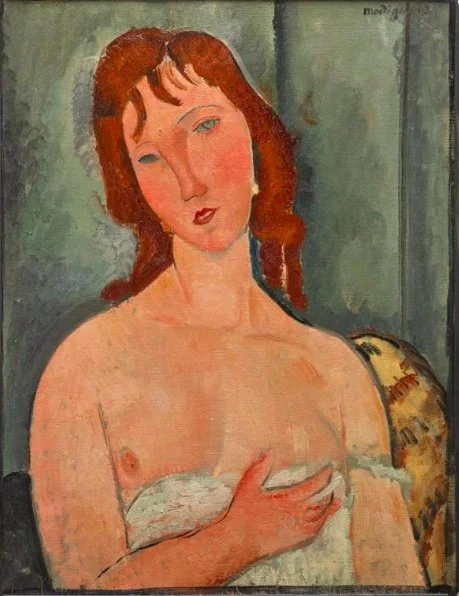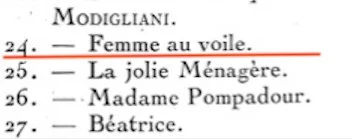Reconsidering a Portrait Not Included in Ceroni
May 31, 2023
(Fig. 1) Portrait of a Young Woman (1916–1919), Dallas Museum of Art, gift of the Meadows Foundation, Inc.
(Not published in Ambrogio Ceroni’s 1970 catalogue)
Portrait of a Young Woman, Unveiled
. . . Mr. Paul Guillaume has above all, in his pictorial stable—if it is permissible to speak that way—two favorite colts. One is Mr. Modigliani . . .
—Les Arts à Paris (May 15, 1919): 12 [1]
The vernissage of Galerie Paul Guillaume’s groundbreaking exhibition Peintres d’Aujourd’hui in December 1918 was quite the affair. Prominent visitors, including Russian artist Natalia Goncharova and art critic Louis Vauxcelles, mingled with collectors Gertrude Stein and Jacques Doucet at the gallery’s prestigious Rue du Faubourg Saint-Honoré location. On view was a selection of thirty paintings by what Guillaume considered to be the most relevant contemporary artists of the day. [2] Alongside more established names such as Henri Matisse, André Derain, and Picasso—the latter strategically attended the opening— Modigliani was represented by four portraits. (Fig. 2)
(Fig. 2) Checklist of Peintres d’Aujourd’hui, published in Les Arts à Paris (December 15, 1918): 10
Although Modigliani was living and working in the south of France at the time and not in attendance, his inclusion in Peintres d’Aujourd’hui represented a key event in his career. The show received widespread critical acclaim and various guests present at the opening—Georges Bernheim, Armand Parent, Georges Menier, and Jos Hessel, among others—would become major collectors of the artist’s work.
Tracing Modigliani’s paintings to lifetime events (he died on January 24, 1920) is critical to establishing a body of work that is unquestionably authentic. This is especially significant for paintings excluded from the most widely accepted Modigliani catalogue, compiled by Ambrogio Ceroni and published in 1970. Three of the works exhibited in Peintres d’Aujourd’hui can be plausibly identified by their descriptive titles but the fourth, Femme au voile (Woman with a veil), has remained a mystery as no painting by the artist is currently known by this title. (fig. 3) [3]
(Fig. 3) Detail of checklist of Peintres d’Aujourd’hui
New research offers compelling evidence that the painting is Portrait of a Young Woman (1916–19), a work omitted from Ceroni’s catalogue and currently in the collection of the Dallas Museum of Art. (Fig. 1) In the 1934 catalogue of the modern French art collection of Danish merchant Christian Tetzen-Lund (1852–1936), the portrait is reproduced with the title Femme au voile. (Fig. 4)
(Fig. 4) Reproduction of Portrait of a Young Woman, 1916–19, titled Femme au voile, in Chr. Tetzen-Lunds samling af moderne fransk malerkunst, pl. 59 [4]
Recently published inventory lists—handwritten and maintained by Tetzen-Lund—furthermore reveal that the collector acquired the work from the Galerie Paul Guillaume in 1919, most likely soon after its inclusion in Peintres d’Aujourd’hui. Another painting on the exhibition’s checklist, Derain’s Le Cheval rouge, likewise appears on Tetzen-Lund’s list of purchases made during 1919. [5] Although on this list Tetzen-Lund refers to the Modigliani painting as La jolie fille rousse, an accompanying photograph sent by Guillaume to Tetzen-Lund identifies it as Femme au voile. (Fig. 5)[6]
(Fig. 5) Photograph sent by Paul Guillaume to Tetzen-Lund; original pasted on index card and inscriptions copied by Danish Art Library, inventory no. NYS 74-10. Title of work: “Femme au voile”
By the mid 1920s, Tetzen-Lund began disposing of much of his substantial art collection. He sent La jolie fille rousse to an auction held on May 19, 1925, at A. Munch-Peterson, Copenhagen, together with another Modigliani work, Portrait d'une jeune fille (now titled Adrienne, c. 1917, Ceroni 64). [7] Both failed to sell and La jolie fille rousse appears on the collector’s list of unsold artworks, dated June 1927. [8] The portrait was presumably sold some time after this date, most likely back to Paul Guillaume, who is credited as its owner in Arthur Pfannstiel’s Modigliani: catalogue presumé, published in 1929. [9]
Historically, five different portraits of what appears to be the same model as depicted in Portrait of a Young Woman have been attributed to Amedeo Modigliani: Jeune femme rousse en chemise; Jeune femme rousse en chemise (La jeune laitière); and Jeune femme rousse en chemise, assise sur un divan were included in Ceroni’s catalogue, while Portrait of a Young Woman and Femme au Camée were omitted. (Fig. 6)
(Fig. 6) Portraits historically attributed to Modigliani, presumably depicting the same model as Portrait of a Young Woman, 1916–19
L to R, Top to bottom:
1) Jeune femme rousse en chemise, 1918; Ceroni 264; Private collection
2) Jeune femme rousse en chemise (La jeune laitière), 1918; Ceroni 266; Batlinger Collection, Albertina Museum, Vienna
3) Jeune femme rousse en chemise, assise sur un divan, 1918; Ceroni 265; Private collection
4) Femme au Camée, c. 1917; not published in Ceroni; current location unknown [10]
Titles of Modigliani’s paintings have generally been fluid and Portrait of a Young Woman is no exception. Following Paul Guillaume’s ownership, the work has been identified by a range of titles, most of which are a variation on Jeune femme: La fille rousse; Le deshabillé; La jeune Suédoise; and, intriguingly, La petite laitière, indicating that the model may have been a young milkmaid.
The presumedly related paintings of this young woman have been identified with similar titles, lending support to the theory that Portrait of a Young Woman is part of this series painted in 1918, while Modigliani was in the south of France. Lacking access to professional models, he customarily relied on ordinary townspeople, such as servants, children, and vendors.
Although Portrait of a Young Woman enjoys an early, notable provenance and publication history, its connection to Tetzen-Lund and to Guillaume’s 1918 show provides the first documented links to Modigliani’s lifetime, likely unknown to Ceroni when he compiled his catalogue. These newly uncovered facts combine to build a convincing case that the painting should be recognized as an authentic work by the artist.[11]
A new technical study of Portrait of a Young Woman, planned by the Dallas Museum of Art, will no doubt produce invaluable information on its methods and materials that can then be compared to Modigliani’s fully acknowledged works, many of which have been explored in depth by recent technical studies undertaken by the Tate, Lille Modern Art Museum (LaM), and the Barnes Foundation. [12]
Leslie Koot
Endnotes
[1] Author’s translation: “ . . . M. Paul Guillaume a surtout, en son écurie picturale,—s’il est permis d’ainsi parler—deux poulains favoris. L’un est M. Modigliani . . .”. Aux Écoutes (December 29, 1918): 17, reprinted in Les Arts à Paris (May 15, 1919): 12.
[2] A vivid account of the vernissage mentions various other eminent guests, including author André Gide, fashion designers and art collectors Paul Poiret and his sister, Germaine Bongard, and various members of French aristocracy. Les Arts à Paris (May 15, 1919): 13.
[3] A follow-up essay that attempts to reconstruct the Peintres d’Aujourd’hui exhibition will be published in the June edition of Spotlight on our website.
[4] Chr. Tetzen-Lunds samling af moderne fransk malerkunst, with a foreword by Oluf Thomsen (Copenhagen: 1934), pl. 59.
[5] Jesper Svenningsen, Tetzen-Lunds kunstsamling: 400 moderne mesterværker spredt for alle vinde (Copenhagen: Strandberg Publishing, 2022), 237. More information on this publication: https://strandbergpublishing.dk/boger/tetzen-lunds-kunstsamling-400-moderne-mestervaerker-spredt-for-alle-vinde/
[6] Special thanks to Jesper Svenningsen for sharing an image of the original photograph, held by the Danish Art Library, and explaining its inscriptions in an email to the author on February 8, 2022: “Unfortunately, the annotations on the photograph's card mount are all library references and have nothing to do with the Guillaume provenance. “NYS 74-61” was the location of the photograph in box 74; "182-27” referred to the acquisition (Tetzen-Lund's gift of photographs was the 182nd acquisition in the year 1927) and “1918?” is the supposed date of the painting. However, from the unmounted photographs that I've found in private hands I know that the photographs that Guillaume sent Tetzen-Lund carried all sorts of other inscriptions such as descriptions of colour and subject, measurements, dates, and identification numbers. None of this information was transcribed onto the library mounts and is now lost.”
[7] Adrienne (Woman with Bangs), 1917, Chester Dale Collection, National Gallery of Art, Washington, D.C. (1963.10.171). https://www.nga.gov/collection/art-object-page.46646.html
[8] Katalog over franske og skandinaviske Billeder tilhørende Tetzen-Lunds Samlinger, der bortsælges ved Auktion i Den frie Udstillings lokaler Mandag den 18. Maj og Tirsdag den 19. Maj (Copenhagen: Den Frie Udstilling, 1925), 32 , 18. Lot 126: La belle fille rousse, 64 x 50 (not reproduced); lot 127: Portrait de Jeune Fille, 55 x 38, reproduced on page 18 of the catalogue. Information on Tetzen-Lund’s list of unsold artworks provided by Jesper Svenningsen, in correspondence with the author, September 24, 2021.
[9] Arthur Pfannstiel, Modigliani: catalogue présumé (Paris : Éditions M. Seheur, 1929), 44 and 49. It appears Pfannstiel mistakenly entered the same work twice, with slightly different titles and provenances: on page 44 as Buste de jeune femme, in the collection of Paul Guillaume (former collection of L. Zborowski, Paris), and mentions the work’s reproduction in André Salmon’s 1926 publication (see endnote 11) on plate 25; then again on page 49 as Buste de femme (tenant son sein gauche avec la main droite), in the collection of J. Netter, Paris, but referencing the image in Salmon’s publication on plate 25.
[10] The earliest (probable) reference to this portrait dates to 1927: Italienische Maler (Zurich: Zurich Kunsthaus, 1927), n.p., no. 107, as Das Mädchen mit Brosche. It is also included in Pfannstiel, 29, as “La Femme au Camée (Béatrice Hastings), col. F. Fénéon, Paris, anc. col. Bing, Paris.” The only known reproduction of the work is published in an auction catalogue from 1941: Collection Félix Fénéon (Paris: Drouot, December 4, 1941), lot 65: La Femme au camée, 116 cm x 73 cm, ill. in b/w, pl. XV. The painting has not been seen publicly since, but may have been at the heart of an unresolved art theft in Brussels in 1986.
[11] The painting’s earliest known publication history traces back to 1926: Carl Einstein, Die Kunst des 20. Jahrhunderts (Berlin: Propyläen-Verlag, 1926), 226, ill. in b/w, as Halbakt (Half nude); André Salmon, Modigliani, sa vie et son oeuvre (Paris: Ed. des Quatres Chemins, 1926), pl. 25, ill. in b/w, as Buste de jeune femme, 1918, Private collection. The work’s earliest known exhibition was in 1930 at the 17th Venice Biennale, most likely as catalogue number 32, Ragazza. The work is visible in an installation photograph of the exhibition, published in an online article: https://www.widewalls.ch/magazine/venice-biennale-history
[12] A high-resolution image of the portrait can be accessed on the Dallas Museum of Art website: https://dma.org/art/collection/object/4227866











